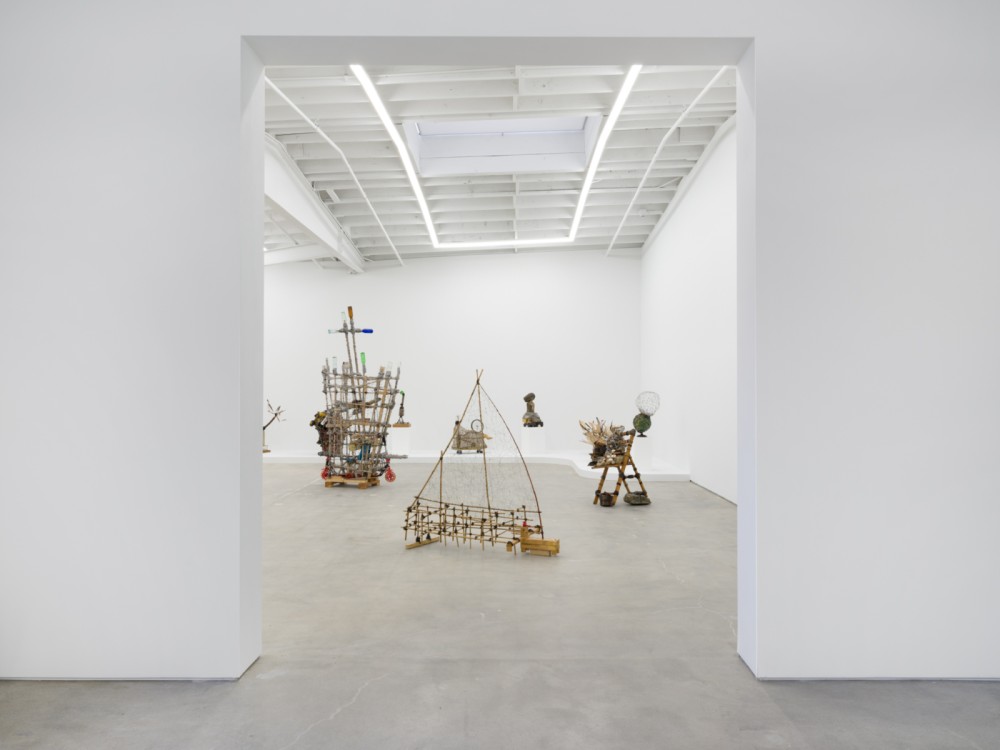
Arthur Simms: The Miracle of Burano
Karma is pleased to present The Miracle of Burano, the first Los Angeles solo exhibition of sculptor Arthur Simms. On view from March 11th to April 29th, 2023, the exhibition brings together works from the 1990s through the present, many of which have never before been exhibited.
Arthur Simms has created a multivalent body of work over the course of his decades-long practice. He works with found objects, often enclosing them in bundles of hemp and wire. Assembling everyday items such as toys, thread spools, glass bottles, feathers, and bricks, Simms creates poetic and unexpected associations between these various materials.
Chester, Alice, Marcia, Erica And Arthur Take A Ride (1993), the earliest work included in the exhibition, resembles a sailing vessel consisting of a weblike layer of knotted rope stretched over a wood mast. The work recalls the 1969 journey of Arthur and his three sisters, accompanied by their father, whose names comprise its title. The family traveled from Jamaica to Brooklyn where they reunited with their mother who had moved to the United States three years prior. The push-pull of relocation and reinvention is ever-present throughout Simms’ body of work. In particular, the memory of immigrating in his early childhood is a foundational reference, manifesting in motifs of sailboats and other vehicles.
In mobile works such as Carnival (2005) and Red Cooper (2004), Simms repurposes skateboards, roller skates, and cars, recalling the moveable sculptures of Constantin Brâncuși. These works appear as if they are resting mid-journey. Simms suspends the functionality of wheels in other works: in Caged Bottle (2006), a web of rope and wire binds together bottles, a birdcage, a skateboard, and a bicycle whose wheel hovers just above the ground, reminiscent of a Marcel Duchamp readymade.
Simms works in both large and small scales but, by his own insistence, always at a human scale, honoring the “fact that it is made by my hands.” He also pays homage to the work of loved ones: when Simms was a fellow at the Academy of Rome in 2002, he began a collaboration with the writer Peter Orner. Initially, Simms used texts written by Orner as a sculptural impetus. In turn, Orner began to compose his texts directly on Simms’ materials, such as a trumpet inscribed with his writings, now a part of Trumpet and a Rocking Chair (2019). Simms’s sculptures venerate the living as well as those who have passed, as in A Citrus Branch for David Fisch (2003), in memory of an artist and friend who died of AIDS in 1993.
A devotional sculptor, Simms preserves the past lives of his materials as well as the memories of those dear to him. Found objects are recontextualized through their associative connections to one another. Simms transforms humble materials, revealing the innumerable routes that traverse through them.
Arthur Simms (b. 1961, Saint Andrew, Jamaica) is an artist based in Staten Island, New York, whose human-scale assemblage sculptures radiate with poeticism and spirituality. Simms’s sculptures are sourced from found and natural materials, and are often bound with rope or wire. Likewise, his work binds together traditions and modern art historical trajectories: Surrealism’s uses of automatism and disjunction, as well as its reliance on the unconscious, are merged with the folk cultures of Jamaica, America, and Haiti, in addition to Australian Aboriginal belief systems. The resulting entanglements, constructed from materials such as bedsprings, empty bottles, bicycles, and worn-out toys, resonate with narratives of belonging, playfulness, and psychic energy. Simms’s sculpture, rather than feeling like an intervention in space, seems to appear spontaneously, as if by magic, like a creation preordained.
Simms’s work was featured in the Kingston Biennial in 2022, the Venice Biennale in 2019, and the inaugural Jamaica Pavilion at the Venice Biennale in 2001. Simms also exhibits site-specific installations, including a floating sculpture displayed on Staten Island’s waterfront in 2018, and a large-scale work in Socrates Sculpture Park in Queens, New York in 1994.
His work is held in the collections of the Hirshhorn Museum, Washington, D.C.; the Yale University Art Gallery, New Haven, Connecticut; the Neuberger Museum of Art, Harrison, New York; and the Aïshti Foundation, Lebanon; Brandhorst Museum, Germany, among others.